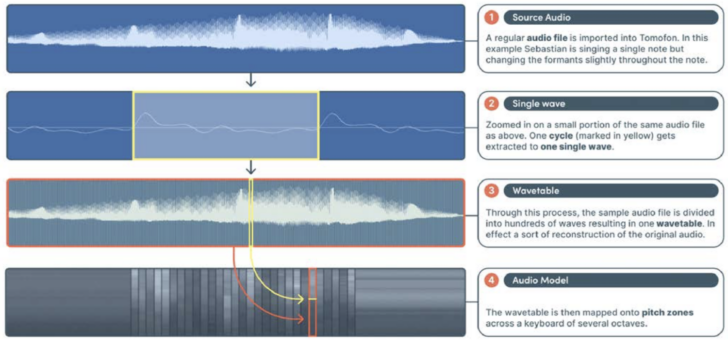Klevgrand has introduced Tomofon – a new software synthesizer, for Mac & Windows, that’s based on seamless morphing between different layers and sections of a massive amount of real audio waves.
They say that this gives an instantly playable synthesizer that can both “sound organic, and also like something out of this world”.
How does it work?
Tomofon converts audio files into a large set of oscillating waves, which then are mapped into pitch zones where each wave represents one layer (a bit similar to how a sampler structures different velocity zones). The main difference is that since each zone is populated with waves instead of ordinary samples, the synth engine can morph between them (both layers and zones). This makes all transitions between zones and layers continuous and seamless.
The structure containing these organized wavetables is called an Audio Model and gives Tomofon its dynamic properties and characteristic sound.

Users can import their own audio files and create new and unique Audio Models. Ordinary audio files (preferably with monophonic content) can be imported and distributed into different pitch zones over the keyboard range, either automatically or manually.
Doing an automatic import is basically a one-click process which instantly results in a playable Audio Model. A manual import gives the user full control of which waves should end up in which pitch zone. Users can share custom Audio Models with others.

Tomofon comes pre-loaded with a pack of 119 Audio Models. Included with your download are also over 160 presets to choose from, to get you going right away.
From there on you can venture further and experiment with the existing Audio Models, or start using the built-in editor of the plug-in, importing your own sounds to shape and deconstruct.
Features:
- Wide selection of factory models and presets
- Integrated audio sample importer and Audio Model editor
- Pitch and (layer) depth envelopes that can be edited by the user
- Envelope times can separately be controlled via MIDI velocity
- Several LFO’s (including Sample and Hold with randomness)
- Modulation matrix (2 x MIDI CC, Velocity and Keymap)
- Monophonic playback with separate glide times for pitch and velocity
- Polyphonic legato playback where started notes syncs envelopes with currently playing ones
- Up to 4 doubling voices with separate pitch, pan and level
- Filter with modulation possibilities
- Post Reverb, Delay and EQ
Audio Demos:
Pricing and Availability
Tomofon is available now, with an intro price of $99 USD through 2023-01-04, $129 thereafter.
Compatibilities/formats: Requires macOS 10.10 or later (optimized for the M1-processor), Windows 7 (SP1) or later, running a AU, VST3 or AAX compatible 64-bit host.

Was struggling to understand this, but this video walks through it – pretty cool! https://www.youtube.com/watch?v=oVN-iV9SeOQ
“different layers and sections of a massive amount of real audio waves” … which begs the question … How does one differentiate a “real” audio wave” form a “fake or imposter” audio wave? Also, I’m assuming that the writer intended “massive number” as opposed to “massive amount”, given that “massive amount” would seem to connotate “a large buildup of noise”!
“real audio wave” – a microphone recording
“not a real audio wave” – a product of synthesis
wasn’t that hard to decipher, was it?
Actually it is pretty hard to decipher, since the product of musical synthesis IS “A REAL AUDIO WAVE”. If it wasn’t, you probably wouldn’t be able to hear it! What would make you think that you couldn’t capture the “product of synthesis” with a microphone, anyway? My point was, since it seems to have gone well over your head, any audio wave is REAL if it can be heard.
that’s just pedantery. if you know what they mean, what’s the problem?
“pedantery” (first, learn to spell the word), maybe. However, that was the basis of my initial comment. Saying things like “real audio wave” makes it sound like there is a claim that there can be any audio wave that is not a real audio wave. In other words, it sounds like unnecessary hype, put there to make it sound like their system is somehow special in that it doesn’t use “artificial audio waves”. I, generally, like their stuff, but as asinine as it might seem, it’s things like this that cause me to just not to want to look further. Make foolish statements, get appropriate responses.
i feel like this thin-skinned, has-been fightiness kind of makes my point for me
somebody was looking for “not synthesized waveforms”
if that makes your semantic day better. ^^
Who was looking for non-synthesized waveforms? It was a statement, not a question. Also, who cares whether the audio is synthesized or not?
Whoever wrote “real audio waves”.
Tried the demo- doesn’t do it for me, the pre-sets are actually a bit bland in my opinion. It looks more interesting on paper than it sounds (it pretty much sounds like a subtractive synth to me).
hm, it sounds like any sampler to me
I guess the point of re-interpretation of a sample as wavetable is to be more flexible with the pitch than a sampler without going into Smurf & Monster land?
The demos on Klevgrand’s site are quite cool. Very creative and playful.
It seems to take the concept of wavetables and adds maybe two or three more dimensions to it. I think their use of “audio model” may be a bit misleading since there already is a thing called modeling.
To me it sounds like a cross between wavetables & sampling, with some nice twists.
I ultimately decided to pass on it, as I doubt I’d use it very much.